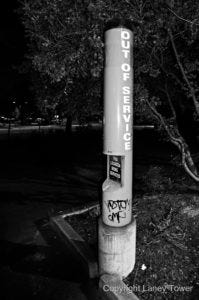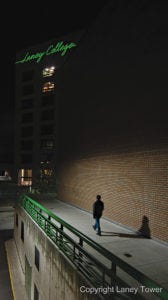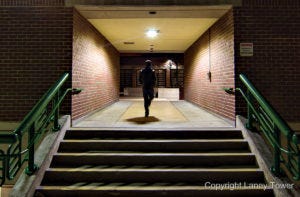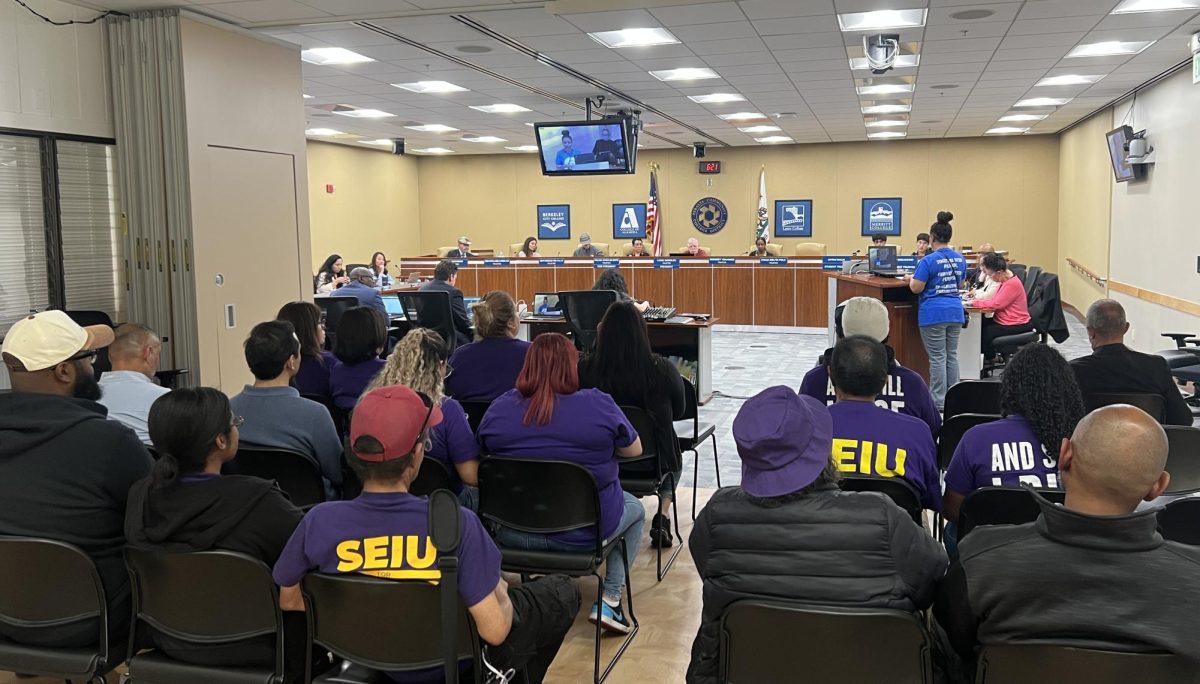Merritt, Laney lag behind other schools in safety
 “We have lots of students,” said Laney College Interim President Patricia Stanley, “and not enough people.”
“We have lots of students,” said Laney College Interim President Patricia Stanley, “and not enough people.”This is at the heart of the explanation for why Laney and Merritt Colleges are in crisis when it comes to student safety: a district-wide system collapsing under the weight of students’ needs.
And although there are possible solutions on the horizon, there is no contingency plan in the meantime, leaving students in the dark both literally and figuratively.
In order for something to get fixed on a Peralta college campus — say, the blue emergency phones at Laney College, only 10% of which are functional — staff must submit a “work order” through a system called Main Star.
Using Main Star, Merritt and Laney have sent in several requests asking for new and additional lighting.
But throughout this system’s lifetime, there has been a lack of transparency between the college staff and the district.
“We can put work orders in, but we don’t get a status of when things are closed.” said Phyllis Carter, Director of Business and Administrative Services. “We put in the work order, we submit it, and we don’t hear anything.”
This is because, when work orders are sent in, the college staff is unable to see whether or not the order was taken into action and if progress is actually being made.
Within the next month, Main Star will be replaced with a new system that will allow for more transparency between the school and the district.
“We will get a notice of when the order gets in and when it closes,” Carter said of the new system.
Staff will be able to check the progress of the repairs being made, and if the school is not satisfied with the repair then they will be able to give feedback.
Lights Up!
 Some work orders have less to do with existing equipment that’s broken, and more to do with equipment that doesn’t exist at all.
Some work orders have less to do with existing equipment that’s broken, and more to do with equipment that doesn’t exist at all.On Dec. 17, 2015, the Department of General Services, which provides centralized services to the district, had a meeting discussing the lighting at Merritt — or lack thereof.
One solution they came up with was possibly installing L.E.D floor lights in parking lot C. However, Nathan Coyle, an employee of local security company Securitas, noted that replacement batteries for the lights would cost $500 each.
Two months later, at a Security and Public Safety Committee meeting in February, Director of General Services Bruce Shapiro stated that the pathway lights and fixtures installed in 2010 never worked properly.
Final decisions on what to do for the lighting at Merritt are yet to be made.
Although Laney College also faces issues having to do with poor lighting on campus, according to Carter, there are other issues even more pressing on campus.
“Right now, our scheduled maintenance for 2016–2017… is to redo elevators in the tower,” said Carter.
Carter said that there have been major safety concerns with our tower elevators “locking people in their, closing down, things like that.”
“[Laney’s parking lots] are right across the street and we have our Safety Aide office there, and we have the highway going by,” Carter said. “So hopefully that deters a little bit of crime.”
Armed Robbery
The elevators and lighting, however, aren’t the only safety related issues occurring at Laney.
Today, “only 10% of phones on-site now work,” Shapiro said at a Security and Public Safety Committee Meeting on Feb. 18, 2016, referring to the blue emergency phones around Peralta college campuses.
After four years of slow movement on repairs, movement towards the replacement of the broken phones is finally being made.
“74 new phones will be ordered and installed,” Shapiro said. “These new phones will have camera capabilities, and speakers for PA broadcasting.”
Depending on whether or not the infrastructure already exists at the sites where they want to install the new phones, the project will take roughly 150 days to complete.
On the evening of Oct. 21, two female Laney College students were robbed at gunpoint, just yards away from the college’s A building. But it wasn’t until almost two weeks later that the Laney community found out.
The two students were not hurt, though they were forced to surrender their cell phones and personal items from their backpacks to the armed robber.
When crimes like this happen, colleges are required by law to warn their communities about the incident and suspects involved as soon as possible. That way, students, faculty, and staff can be on the lookout for the suspects and be extra careful to protect themselves, especially in the evenings.
In this case, none of this happened. On Nov. 2, postings around campus suddenly appeared, describing the crime and the suspects, but with no explanation of why it had taken three weeks for the campus to be alerted.  On top of endangering the Laney community, the delay was a clear violation of the Jeanne Clery Act, which states the reports must “be provided to students and employees that will aid in the prevention of similar occurrences.”
On top of endangering the Laney community, the delay was a clear violation of the Jeanne Clery Act, which states the reports must “be provided to students and employees that will aid in the prevention of similar occurrences.”
The act carries strict punishments for colleges: up to tens of thousands of dollars in civil penalties.
This incident at Laney reflects a serious gap between the district, the school and the students.
In the meantime, we do have an established safety aide program that is constantly improving.
If you would like to schedule a safety aide to escort you, you can call the safety aide office at (510) 464–3126.
If you need the immediate accompaniment of a safety aide without an appointment, call the sheriff’s department. They will contact the safety aides and send one down to you. The number of the sheriff’s department is (510) 465–3514.
You can also call the safety aide evening administrator at (510) 599–9411.
Weak Signals
Even the Laney Safety Aides program, however, has run into its own maintenance issues.
Last year, Laney safety aides were having trouble communicating with the other schools; it turned out that this was due to the fact that the other colleges had yet to install the radio repeaters necessary for cross-campus communication. Laney’s radio tower was already up and running.
Within the last few months, the District has bought new radios and towers for every school, catching them up to Laney on that front. The other towers are in the process of being installed. Once they are up, all the schools will be able to communicate with one another.
Laney’s step ahead of the curve occurred because Laney officials made a point of demanding radios and infrastructure for safety aides, even though the other schools towers were not yet installed. This was because the program wanted to be able to at least communicate with itself within the campus.
Knowledge Gap
One of the main reasons as to why many of these issues may feel like they are taking longer to fix is due to the fact that many people within the district are being shuffled around.
“There is an ageing out of the administrative positions in community colleges,” said Carter. “With the baby boomers retiring, there is a big knowledge gap of people who are prepared to take leadership roles.”
Like Laney College, Berkeley City College also recently lost their president, who became a chancellor.
“It’s hard work to be in these positions,” said Stanley, who will serve as Laney’s interim president through 2016.
Look for a follow-up article on these safety issues in our next issue, available on May 5.
Call the safety aide office at (510) 464–3126.
Call the sheriff’s department at (510) 465–3514.
Call the safety aide evening admin at (510) 599–9411.
What’s working?
90%: Percent of Laney’s blue emergency phones not operational
70: Amount of new blue emergency phones to be ordered and installed at Laney
265: Amount of radios to be deployed to the Peralta Colleges
39: Amount of radios received by Laney on Feb. 26, 2016

























